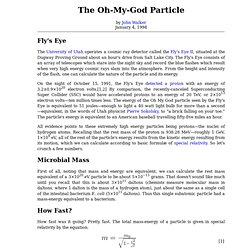

12,000 Years Old Unexplained Structure. The Relativity of Wrong by Isaac Asimov. By Isaac Asimov I received a letter from a reader the other day.

It was handwritten in crabbed penmanship so that it was very difficult to read. Nevertheless, I tried to make it out just in case it might prove to be important. In the first sentence, he told me he was majoring in English Literature, but felt he needed to teach me science. (I sighed a bit, for I knew very few English Lit majors who are equipped to teach me science, but I am very aware of the vast state of my ignorance and I am prepared to learn as much as I can from anyone, however low on the social scale, so I read on.) It seemed that in one of my innumerable essays, here and elsewhere, I had expressed a certain gladness at living in a century in which we finally got the basis of the Universe straight.
These are all twentieth-century discoveries, you see. The young man then quoted with approval what Socrates had said on learning that the Delphic oracle had proclaimed him the wisest man in Greece. No one knows nothing. The Curious Case of the Immortal Jellyfish. Brief Answers to Cosmic Questions. Structure of the Universe Does the Universe have an edge, beyond which there is nothing?

Are the galaxies arranged on the surface of a sphere? Why can't we see the whole universe? Does the term "universe" refer to space, or to the matter in it, or to both? Schopenhauer's Stratagems. Arthur Schopenhauer (1788-1860), was a brilliant German philosopher.

These 38 Stratagems are excerpts from "The Art of Controversy", first translated into English and published in 1896. Carry your opponent's proposition beyond its natural limits; exaggerate it. Solar-powered 3-D printer prints glass from sand. Amazing Electron Microscope Shots... - melodymaker's posterous. Columbia Engineers Prove Graphene is Strongest Material. July 21, 2008 Columbia Engineers Prove Graphene is the Strongest Material Research scientists at Columbia University’s Fu Foundation School of Engineering and Applied Science have achieved a breakthrough by proving that the carbon material graphene is the strongest material ever measured. Graphene holds great promise for the development of nano-scale devices and equipment. It consists of a single layer of graphite atoms arranged in a hexagonal lattice, similar to a honeycomb. As a two-dimensional material, every atom is exposed to the surface.
Until now, graphene’s estimated strength, elasticity and breaking point were based on complex computer modeling theories. “Our team sidestepped the size issue by creating samples small enough to be defect-free,” said Columbia Professor Jeffrey Kysar. The studies were conducted by postdoctoral researcher Changgu Lee and graduate student Xiaoding Wei, in the research groups of mechanical engineering professors Kysar and James Hone. 10 Futuristic Materials. Lifeboat Foundation Safeguarding Humanity Skip to content Switch to White Special Report 10 Futuristic Materials by Lifeboat Foundation Scientific Advisory Board member Michael Anissimov. 1.

Aerogel protecting crayons from a blowtorch. This tiny block of transparent aerogel is supporting a brick weighing 2.5 kg. The Art of Complex Problem Solving. Wolfram Alpha. Center for Astrophysics. Physik. Relativity Explained in a Nutshell. Touch Trigonometry. Physics, 10 Unsolved Problems. Black Hole Theory. “Our own Universe may be the interior of a black hole existing in another universe.”

In a remarkable paper about the nature of space and the origin of time, Nikodem Poplawski, a physicist at Indiana University, suggests that a small change to the theory of gravity implies that our universe inherited its arrow of time from the black hole in which it was born. Poplawski proposes that the universe in which the Earth exists may be located within the wormhole of a black hole which itself exists in an even larger universe. A universe could exist 'inside every black hole,' claims scientist Using an adaptation of Einstein's general theory of relativity, Poplawski analysed the theoretical motion of particles entering a black hole. He concluded that it was possible for a whole new universe to exist inside every black hole, which could mean that our own universe could be inside a black hole as well.
Translated, this means that our universe inherited its arrow of time from its source. Other Sources: The Oh-My-God Particle. By John Walker January 4, 1994 Fly's Eye The University of Utah operates a cosmic ray detector called the Fly's Eye II, situated at the Dugway Proving Ground about an hour's drive from Salt Lake City.

The Fly's Eye consists of an array of telescopes which stare into the night sky and record the blue flashes which result when very high energy cosmic rays slam into the atmosphere. From the height and intensity of the flash, one can calculate the nature of the particle and its energy. On the night of October 15, 1991, the Fly's Eye detected a proton with an energy of 3.2±0.9×1020 electron volts.[1,2] By comparison, the recently-canceled Superconducting Super Collider (SSC) would have accelerated protons to an energy of 20 TeV, or 2×1013 electron volts—ten million times less. All evidence points to these extremely high energy particles being protons—the nuclei of hydrogen atoms.
Microbial Mass How Fast? How fast was it going? And thus, approximately: v = 0.9999999999999999999999951 c.